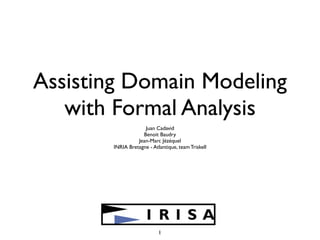
Point GEODES
- 1. Assisting Domain Modeling with Formal Analysis Juan Cadavid Benoit Baudry Jean-Marc Jézéquel INRIA Bretagne - Atlantique, team Triskell 1
- 2. Domain Models • A conceptual model of a system which describes the various entities involved in that system and their relationships. Domain Model for Insurance 2
- 3. Typical Domain Modeling Domain Model Raw Modeling Space 3
- 4. Typical Domain Modeling Incorrect Instances There is an intention not expressed by the metamodel on its own. 4
- 5. Precise Domain Modeling Limit the number of solutions to find the precise modeling space 5
- 6. Precise Domain Modeling OCL • Write constraints along with the domain model. OCL OCL • The most popular language is OCL OCL (Object Constraint OCL Language) 6
- 7. Example: Metamodeling Feature Models A B B 7
- 8. Example: Metamodeling Feature Models A B B Two features cannot have the same name 7
- 9. Example: Metamodeling Feature Models 8
- 10. Example: Metamodeling Feature Models There cannot be mutual exclusivity between a parent feature and its children. 8
- 11. Example: Metamodeling Feature Models A B 9
- 12. Example: Metamodeling Feature Models A B The or operator must have at least two operands 9
- 13. Precise Domain Modeling • A given set of OCL constraints could include bad instances, and leave OCL out good instances. OCL • How to find the good set of OCL OCL constraints that correctly describes the modeling space? 10
- 14. Exploring the Modeling Space: Generating Instances Kermeta2Alloy Metamodel Metamodel in Ecore in Alloy Pramana: Generates conforms to AlloySolution Metamodel Instances using Solution2xmi Instances Instances Alloy in XMI in Alloy XML 11
- 15. Pramana Architecture 12
- 16. Challenges with Pramana • Robustness/Enough testing • Alloy limitations • Small scope • Integer numbers • Maximize distance between metamodel instances • OCL2Alloy: A difficult transformation 13
- 17. Understanding the use of OCL (1) • Study of 519 invariants from three OMG specifications: UML, OCL and CORBA Component Model • Definition of Metrics • Size of Metamodel • Invariant complexity w.r.t. the metamodel • Invariant complexity w.r.t to OCL 14
- 18. Understanding the use of OCL (1I) • 88% of invariants were written with 36% of the OCL language. • Most invariants are defined over two or less domain elements (i.e. class attributes) • Result: Catalog of recurring patterns in OCL invariants. 15
- 19. Automatic Invariant Derivation (I) • Prototype to match patterns from Catalog • Input: Metamodel, correct instances and incorrect instances. • Matching instances marked as incorrect by the user • Incorrect motifs • Derive OCL invariant from template • Test derived instances marked as correct by the user 16
- 20. Automatic Invariant Derivation (II) Pattern 1 Pattern 2 Pattern n Ecore+OCL Ecore+OCL Ecore+OCL Metamodel Automatic Metamodel Correct Invariant + OCL Instances Derivation Incorrect Instances 17
- 21. Strategies for Mining patterns • Strings -> bio-inspired computing, bioinformatics • Graphs -> graph grammars, mining graph bases • Relational -> R, data mining algorithms
- 22. Algorithms • We need: • Match existing patterns (from a predefined catalog) • Find new patterns (mining correct/incorrect instances) • We could get them from: • Bio-inspired computing, bioinformatics • Graph grammars: structure learning, PEGG • Relational data-mining • Inductive-Logic programming
- 23. Protocol List<OclExpression> mineInvs(List<Object> goodInst, List<Object> badInst){ #Encode instances #Match with existing patterns from catalog #Find new patterns }
Notes de l'éditeur
- \n
- \n
- \n
- \n
- \n
- \n
- \n
- \n
- \n
- \n
- \n
- \n
- \n
- \n
- \n
- \n
- \n
- \n
- \n
- \n
